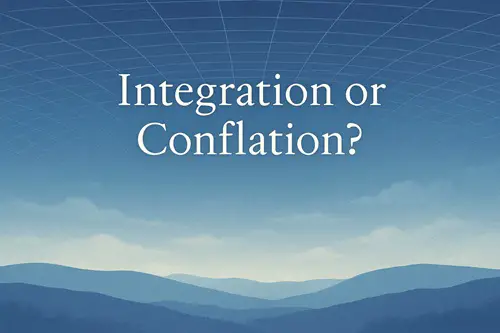|
TRANSLATE THIS ARTICLE
Integral World: Exploring Theories of Everything
An independent forum for a critical discussion of the integral philosophy of Ken Wilber
  Frank Visser, graduated as a psychologist of culture and religion, founded IntegralWorld in 1997. He worked as production manager for various publishing houses and as service manager for various internet companies and lives in Amsterdam. Books: Ken Wilber: Thought as Passion (SUNY, 2003), and The Corona Conspiracy: Combatting Disinformation about the Coronavirus (Kindle, 2020). Frank Visser, graduated as a psychologist of culture and religion, founded IntegralWorld in 1997. He worked as production manager for various publishing houses and as service manager for various internet companies and lives in Amsterdam. Books: Ken Wilber: Thought as Passion (SUNY, 2003), and The Corona Conspiracy: Combatting Disinformation about the Coronavirus (Kindle, 2020).
Check out my other conversations with ChatGPT Integration or Conflation?A Scholarly Critique of Wilber's Science-Religion SynthesisFrank Visser / ChatGPT
 Ken Wilber's intellectual project—particularly as developed in Sex, Ecology, Spirituality and later in A Brief History of Everything, Integral Spirituality, and the online Integral Life discussions—positions itself as a long-awaited reconciliation between scientific empiricism and spiritual metaphysics. The promise was twofold: first, to acknowledge the explanatory accomplishments of modern science, and second, to rescue religion from marginalization by reframing contemplative insights as legitimate knowledge rather than mere belief. In the late twentieth and early twenty-first century context, this ambition resonated deeply. Secularization theory was losing predictive power; neuroscience had begun investigating meditation; evolutionary psychology re-engaged perennial questions about mind and morality; and global interconnectedness made comparative mysticism more visible than ever. Within this intellectual climate, Wilber's project appeared not only ambitious but timely. Yet as Wilber's framework expanded, a methodological problem emerged: the conceptual rigor required to keep scientific and religious claims distinct gradually eroded. Integration, at its best, requires respecting differences while clarifying correspondences. But Wilber's later work increasingly collapses these distinctions through linguistic drift, metaphorical overreach, and category mistakes that ultimately dissolve rather than illuminate the epistemic boundaries between science and spirituality. The central issue is not that Wilber includes spirituality in philosophical discourse, but that he treats spiritual metaphysics as an explanatory engine for empirical phenomena—especially evolution, cosmology, and consciousness—without meeting the evidentiary and methodological standards of the scientific disciplines he invokes. I. Methodological Pluralism as Premise — and ProblemWilber's epistemological foundation rests on what he calls the “Three Strands of Knowledge”: injunction, experience, and communal confirmation. This framework is presented as a meta-methodology capable of validating everything from laboratory physics to Tibetan Dzogchen meditation. However, this framework presupposes what it claims to prove: that all valid knowledge domains share a structural epistemic form. But scientific methods are not merely injunction → experience → verification. They include reproducibility, public operationalization, independence from first-person subjectivity, and mathematical formalization. Mystical methods, by contrast, hinge on subjective training, phenomenological introspection, and interpretive frameworks embedded in metaphysical traditions. Treating these as structurally equivalent requires abstraction so broad that essential features of each domain are lost. This is the first step where integration shades into conceptual flattening. II. Category Errors: When Spiritual Explanations Enter Scientific Domains
Human cognitive and spiritual development becomes a microcosmic expression of a universal metaphysical process. None of these transitions meet the standards of scientific causal inference—there is no mechanistic explanation, falsifiable hypothesis, or empirical necessity linking developmental psychology, cosmic evolution, and contemplative phenomenology. The shift is linguistic rather than evidential: semantic resonance becomes ontological claim. The structure resembles what philosophers of science call illicit inference or explanatory slippage. What begins as interpretation ends as assertion. III. The Role of Metaphor and the Problem of Ontological InflationWilber frequently uses terms such as Eros, Spirit, Drive, or Consciousness-itself to describe the directional unfolding of the cosmos. Initially these terms appear as hermeneutic lenses—ways to make sense of emergent order. But over time, these metaphors acquire ontological weight. They are no longer interpretive aids; they are posited as literal mechanisms operating in the physical universe. This is where the integration collapses into metaphysical inflation:
The rhetorical elegance hides a shift in epistemic footing: from explanatory humility to metaphysical certainty. IV. The Missing Dialogue With Contemporary ScienceOne striking feature of Wilber's later work is its declining engagement with scientific theory at the level of detail necessary for genuine interdisciplinary dialogue. Evolutionary biology, artificial intelligence, cognitive neuroscience, complexity theory, and cosmology have advanced rapidly since the 1990s, yet Wilber's interpretations remain rooted in now-dated frameworks and secondary sources. Instead of engaging with mainstream research, Wilber selectively cites scientists who appear to support his metaphysical commitments, while dismissing or ignoring countervailing evidence. This selective epistemology mirrors theology more than science: the conclusion precedes the inquiry. V. When Integration Requires RestraintA robust integration of science and religion would require:
Wilber's early work showed sensitivity to these boundaries. Over time, however, his project drifted toward totalizing synthesis—where science and spirituality are not complementary but ultimately identical expressions of Spirit-in-evolution. The result is not integration but collapse: multiple epistemologies are subsumed into a single metaphysical superstructure. Conclusion: The Lesson of an Overextended SystemKen Wilber's project remains historically significant as an attempt to bridge one of the central divides of modern thought. The failure is not in the aspiration but in the method. Integration requires precision, patience, and the courage to allow difference—not the impulse to smooth it away. Where Wilber once traced distinctions, he now asserts unity. Where he began with epistemic modesty, he ends with metaphysical certainty. In that transition, the dream of integrating science and religion gives way to a conflation that satisfies metaphysical longings but abandons rigor. The irony is this: had Wilber preserved the boundaries he initially articulated, his system might have become a platform for genuine interdisciplinary engagement rather than a monolithic metaphysical system awaiting assent. His work thus offers not a model of integration—but a cautionary tale of how easily integration, without disciplined language and methodological restraint, becomes indistinguishable from metaphysical appropriation dressed in the language of synthesis.
Comment Form is loading comments...
|